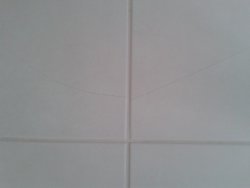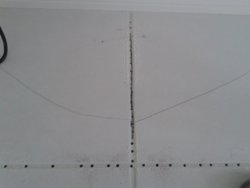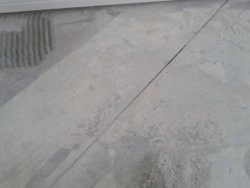New to the forum – excellent information!
We have a large floor area tiled in a holiday home in Florida where there were some record temperatures last month.
The tiling was done when the house was new 21 years ago onto the concrete slab base of the house and looked an excellent job.
Two tiles were noticed with hairline cracks, which when we looked was actually four raised tiles, by about 1cm at the highest point.
The four tiles were removed and revealed that there is a diagonal expansion gap in the concrete, over which there was a paper strip which had detached from the slab.
The pictures are pretty self-explanatory. 18inch Tile and Grout gap is wide at about 5mm – those are 3/16th drill holes.
Talking to the friendly local neighbours they, and others, seem to have had similar problems over the years and seem to accept that ‘tiles crack’ -which says something about how relaxed the sun makes you! Being American they just have them replaced and then watch them crack again!
Now back in England I have been reading the forum info, and elsewhere, on expansion gaps required for tiles!
The area in question is something like 7 x6 metres with no expansion gaps.
The paper strip is presumably designed as an uncoupling membrane to allow the movement in the high temperatures they get, but I am guessing with extended periods of higher temperatures it just wasn’t adequate.
We do have some spares, so when we get back there again, I plan to replace with new paper strip (or similar) and put in a Silicon expansion gap just in that small area,( since we don’t have enough to go right across the room)
So is there a Silicon that looks like grout, rather than a smooth finish?
Could a very thin layer of grout be used to cover the Silicon and disguise it, still allowing movement?
What’s wrong with my plan?
Thanks for reading.
We have a large floor area tiled in a holiday home in Florida where there were some record temperatures last month.
The tiling was done when the house was new 21 years ago onto the concrete slab base of the house and looked an excellent job.
Two tiles were noticed with hairline cracks, which when we looked was actually four raised tiles, by about 1cm at the highest point.
The four tiles were removed and revealed that there is a diagonal expansion gap in the concrete, over which there was a paper strip which had detached from the slab.
The pictures are pretty self-explanatory. 18inch Tile and Grout gap is wide at about 5mm – those are 3/16th drill holes.
Talking to the friendly local neighbours they, and others, seem to have had similar problems over the years and seem to accept that ‘tiles crack’ -which says something about how relaxed the sun makes you! Being American they just have them replaced and then watch them crack again!
Now back in England I have been reading the forum info, and elsewhere, on expansion gaps required for tiles!
The area in question is something like 7 x6 metres with no expansion gaps.
The paper strip is presumably designed as an uncoupling membrane to allow the movement in the high temperatures they get, but I am guessing with extended periods of higher temperatures it just wasn’t adequate.
We do have some spares, so when we get back there again, I plan to replace with new paper strip (or similar) and put in a Silicon expansion gap just in that small area,( since we don’t have enough to go right across the room)
So is there a Silicon that looks like grout, rather than a smooth finish?
Could a very thin layer of grout be used to cover the Silicon and disguise it, still allowing movement?
What’s wrong with my plan?
Thanks for reading.
Attachments
-
 Two Cracked Tles.jpg37.2 KB · Views: 67
Two Cracked Tles.jpg37.2 KB · Views: 67 -
 Four Tiles Raised.jpg33.9 KB · Views: 59
Four Tiles Raised.jpg33.9 KB · Views: 59 -
 Cracks Highlighted & Grout Drilled.jpg48.6 KB · Views: 61
Cracks Highlighted & Grout Drilled.jpg48.6 KB · Views: 61 -
 Diagonal Paper Strip Showing Adhesion.jpg72.7 KB · Views: 62
Diagonal Paper Strip Showing Adhesion.jpg72.7 KB · Views: 62 -
 Concrete Expansion Gap Showing Adhesion to Paper.jpg84.6 KB · Views: 58
Concrete Expansion Gap Showing Adhesion to Paper.jpg84.6 KB · Views: 58 -
 Expansion gap showing paper track.jpg76.6 KB · Views: 55
Expansion gap showing paper track.jpg76.6 KB · Views: 55




